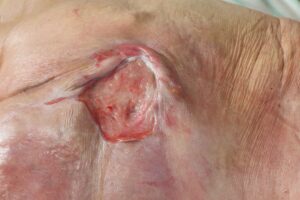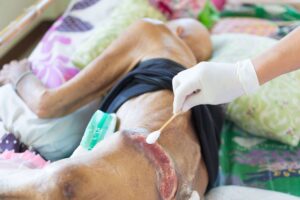 Pressure ulcers also referred to as bedsores, pressure injuries, and decubitus ulcers occur when areas of the skin break down due to prolonged pressure that lowers the blood flow to the area. Pressure ulcers are a common problem for older adults, wheelchair users, or those in a hospital bed for an extended amount of time without movement.
Pressure ulcers also referred to as bedsores, pressure injuries, and decubitus ulcers occur when areas of the skin break down due to prolonged pressure that lowers the blood flow to the area. Pressure ulcers are a common problem for older adults, wheelchair users, or those in a hospital bed for an extended amount of time without movement.
Although pressure ulcers can happen anywhere on the body, they usually occur on the more bony parts of the body including the hips, back, elbows, heels of the feet, ankles, shoulder blades, tailbone, and the back of the head. For some, pressure ulcers can be uncomfortable and interfere with quality of life, for others they can be even more dangerous and potentially life-threatening if not cared for. Fortunately, most pressure sores can be treated and through proper wound care even prevented.
Risk Factors and Causes of Pressure Ulcers
Pressure ulcers are a type of slow healing wound caused by prolonged pressure that reduces blood flow or friction that can make the skin more fragile. Some of the people who might be at added risk of developing pressure ulcers include:
- Older individuals
- If an injury or surgery causes prolonged inactivity
- Paralysis or not being able to move without assistance
- Obesity and/or poor diet
- Disorders that impair circulation and skin strength such as diabetes
- If you suffer from incontinence
- If your injury has caused a loss of sensation
Different Stages of Pressure Ulcers
 Pressure ulcers are generally categorized into four stages depending on how deep the wound is and the severity of the symptoms. Categorizing the wound into these stages can help wound care specialists determine the right course of treatment.
Pressure ulcers are generally categorized into four stages depending on how deep the wound is and the severity of the symptoms. Categorizing the wound into these stages can help wound care specialists determine the right course of treatment.
- Stage 1: The first stage is the least severe. As the blood supply to the skin cuts off, the skin dies, followed by a reddened, painful area. During this stage, the skin does not become white when pressure is applied and the ulcer has not yet broken through the skin. With early intervention, a stage 1 ulcer can heal within a few days.
- Stage 2: categorized by the formation of an open sore as the skin blisters. During this stage the top two layers of skin (epidermis and dermis) have been broken, potentially forming a shallow wound. Stage 2 ulcers typically heal within a few days to a few weeks.
- Stage 3: categorized by a sunken hole known as a crater or ulcer caused by tissue damage under the skin. During this stage, the sores have fully broken through the skin and fatty tissue can often be seen. Stage 3 ulcers can take anywhere between a month to a few months to fully heal.
- Stage 4: The final stage is the most severe and serious. During stage 4, the pressure ulcer has become so deep that they have started to damage the underlying muscle and in severe cases the bones. At this stage, there is a higher risk of infection. Due to how severe these types of ulcers are, they can take anywhere between a few months to a couple of years to fully recover.
Although less common, deep pressure injury and unstageable sores are two types of severe pressure ulcers that don’t fall into the above stages. These types of ulcers can be more difficult to diagnose and should be addressed by a specialist.
Development and treatment of pressure ulcers depend upon the care you receive. Diagnosis is followed by ulcer staging which, in conjunction with the degree of pain and time of onset, helps determines the course of wound care.
Treatment for Pressure Ulcers
A multi-pronged approach of lowering pressure on injured areas, thoroughly cleaning the wound, managing pain, preventing further infection, and ensuring dietary care is an ideal way to deal with pressure ulcers.
Reducing Pressure
Since pressure ulcers develop from prolonged friction, minimizing the source prevents the condition from worsening and the formation of new ones. This can be achieved through regular repositioning and using better support surfaces like specialized mattresses and cushions.
Repositioning
Changing your position frequently can help avoid making pressure ulcers worse. How often you need to reposition yourself will depend on your circumstances as well as what type of surface you are on. For example, wheelchair users are advised to change position every fifteen minutes, whereas bedridden people should try to reposition every two hours. Devising a repositioning schedule based on the severity of your injury and the type of material you lay on can help make sure you stay on track.
Special Support Surfaces
There is specialized equipment to help alleviate pressure on the wound site. A specially designed dynamic mattress or static foam is typically used for bedsores due to its pressure redistribution capabilities.
Special pillows, booties, mattress pads, and foam cushions are available, with some being water or air-filled for a more comfortable experience. If your ulcer is very severe, a sophisticated system with an air pump may be recommended by your doctor.
Do not blindly purchase any mattress online because the best cushion depends on your ulcer, whether you are in a wheelchair or a bed, as well as other factors. Shape and material options also vary according to need and preference. Consult with your wound care specialist for recommendations on what you might need.
Wound Care For Pressure Ulcers
 While stage 3 and 4 pressure ulcers should be cleaned and treated by a wound care specialist, there are things you can do to care for wounds that are in the first two stages. That said, it’s still recommended to seek professional guidance on proper caring methods.
While stage 3 and 4 pressure ulcers should be cleaned and treated by a wound care specialist, there are things you can do to care for wounds that are in the first two stages. That said, it’s still recommended to seek professional guidance on proper caring methods.
Added pressure can cause the ulcer to break the skin, so the first step in treating a pressure ulcer is to alleviate excess pressure. Using blankets or pillows can be helpful if you are lying down. Try to keep the wound site clean and dry.
Gently washing the area with mild soap and water is sufficient to help a Stage I sore, while saline (salt water) or specific cleaner can be used for Stage II sores to remove loose, dead tissue. Avoid using hydrogen peroxide and iodine cleansers that could further damage the skin.
Wound Dressing For Pressure Ulcers
A wound care specialist may recommend wound dressings that can help keep the site clean and dry to avoid infection. Depending on the wound and its severity, your specialist may recommend a specific type of dressing to use.
Though the right dressing depends upon the size and stage of your ulcer, gauze dressings are not advised for this situation. Instead, specially designed dressings like those made from alginate (with seaweed, containing sodium and calcium), hydrocolloid (with a gel that enhances cellular growth), and hydrofibers are often used.
A specialist can also walk you through the proper way to dress your wound. It’s also important to be on the lookout for any signs of infection.
Treating Stage 3 and 4 Pressure Ulcers
As referenced above, it’s crucial to seek professional support as soon as possible if you have a stage 3 or 4 pressure ulcer. The more severe the wound, the higher the risk of infection. If your ulcer is categorized as stage 3, your specialist might recommend antibiotics if there is an infection and wound debridement to prevent infection and facilitate healing. Stage 4 pressure ulcers require immediate medical attention and could require additional interventions like surgical options.
Preventing Pressure Ulcers
While in some cases, it can be difficult to prevent pressure ulcers from developing, there are certain steps that you can put into place to help lower your risk.
- Regularly readjust your position on a set schedule.
- Lift yourself if possible or look into special wheelchairs that help relieve pressure
- Reducing pressure on high risk areas with things like padding, cushions, and specialized mattresses.
- Lightly powder your sheets to avoid friction.
- Keep your skin clean and dry. Moisture barrier creams can also help protect the skin.
- Regularly examining for warning signs and symptoms of sores. If you can’t see the area ask someone for help.
- Maintain a healthy, well-balanced diet that promotes wound healing.
- Have a regular sleep schedule.
- If your pressure ulcers are painful, you can ask about non-steroidal anti-inflammatory drugs like Advil (ibuprofen).
- Light exercise and stretches can help circulation if recommended by your specialist.
- Avoid massaging the skin around the wound to avoid further damage.
- Ring shaped cushions can actually impair blood flow so it’s best to avoid them.
- Avoid smoking that can impair blood circulation.
Finally, you should contact a physician as soon as you feel the situation is out of your control. For example, if new sores develop, your current one changes or you see any sign of infection. Some of the signs to watch out for include pus, foul smell, redness and tenderness around the sore, and fever. You should not wait until the situation gets worse.
Specialized Wound and Skin Care
Without proper care, most pressure ulcers only get worse. That’s why it’s crucial to let your wound care specialist know if you spot any signs of one developing. They can help recommend and execute the best course of treatment to facilitate healing and help prevent them from coming back.
If you or someone you care for have suffered a serious wound or is at risk of developing a pressure ulcer the expert team at West Coast Wound Center is here to help. The specialized physicians and medical staff at our wound care center in Fresno are equipped to treat a complete range of wound types and skin concerns including pressure ulcers and bedsores.
Through our fully integrated wound and dermatology care, we are able to heal pressure ulcers 50% quicker than other practices.
Book an appointment at West Coast Wound Center today and let us help you heal and restore your quality of life.
